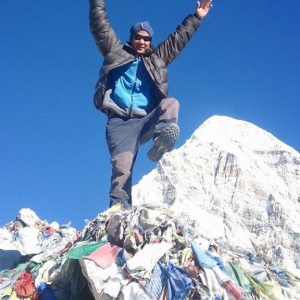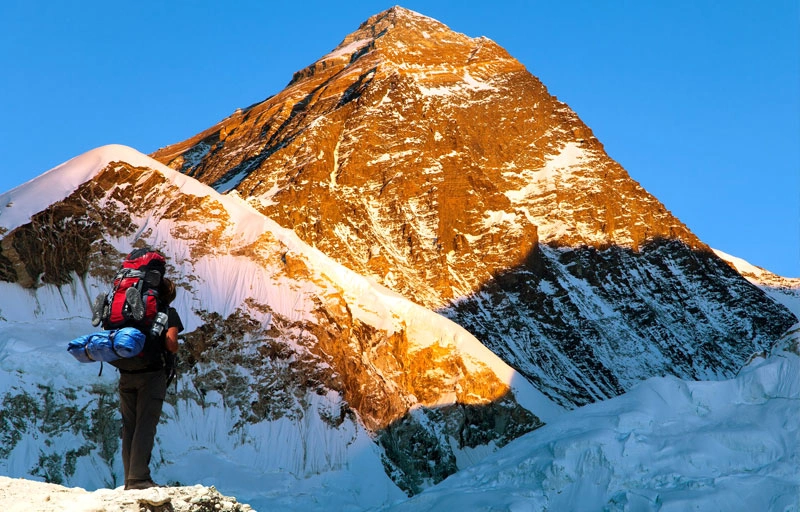When Is the Everest Climbing Season 2026? Best Months & Weather Windows

With its immense global attraction as the ultimate mountaineering challenge Everest Climbing Season 2026 is the ultimate adventure, attracting mountaineers throughout the world. It is a truly great and exceptional personal feat to have stood at the top of Everest, but it is also a great witness to human strength in the face of extreme environments.
Time is the determinant of success and security in climbing on Everest. Correct timing through good weather days is the number one factor in the minimization of risks of extreme wind, snow, and cold. Therefore, by choosing an appropriate season, the probability of successful summit and descent is raised.
Everest Climbing Season 2026 is mostly in the seasons between March and May since it offers stability just before the monsoon arrives. The second window is the autumn from late September to early November. Each of the two seasons also has crucial weather windows that can boost safety and peak success.
Overview of Everest Climbing Seasons
Everest Climbing Season 2026 has two major windows, including spring (April to May) and autumn (September to November). These periods offer favorable weather conditions and a stable climate, which are necessary to achieve a successful summit and stay during the expedition.
The most popular window for the Everest Climbing Season 2026 is during the warm and low avalanche threat spring season. The climbers take advantage of the jet stream flowing northwards, creating calm wind and clear skies, which is very important in making climbing summits.
Autumn is another perfect time for the Everest Climbing Season 2026. Autumn has clear skies and is less cloudy, but is less stable as compared to spring. The temperature is lower, and the jet stream once again redirects, opening sections of low wind which offer the climbers a chance to ascend successfully to the summit.
Everest expeditions do not go well during the winter and monsoon seasons. The winter is excessively cold, there is a lot of wind, and great snow, making climbing very dangerous. Monsoon rainfall is extensive, and insecure weather fronts add to the threat of avalanches and inflict decreased sight, so climbing should not be done during the monsoon season.
Spring 2026 Climbing Season (April–May)
The spring 2026 climbing season (April to May) is the most common and successful, being a time of favorable and quite stable weather conditions. To access the Everest Climbing Season 2026, climbers around the world would choose this season as it is the most convenient in safety, ease of access, and increased likelihood of summiting Everest.
In this season, the weather becomes more stable with the jet stream pushing northwards, lowering the strong winds. This introduces a more open summit window of less extreme conditions, opening up more chances to climb safely.
A large number of visitors come in the spring and take advantage of the good weather windows. Routes with frequent traffic install fixed ropes to facilitate climbing and reduce the risks of accidents. The use of fixed ropes also makes the passage through tricky areas more direct. These are elements that heighten the summit rates of the
Everest Climbing Season 2026.
The perfect summit-push normally takes place during the second half of May when the weather is of maximum stable. To prevent being hit by storms and high winds, climbers take precautions, ensuring they have a high probability of completing the climb.
Spring 2026 predictions show that weather patterns will be close to what they have been in the past years. Developments with regard to weather forecasting offer climbers more insights, as well as informed decisions in terms of climbing Everest, but we can’t fully rely on weather forecasts only.
Autumn 2026 Climbing Season (September–November)
The fall 2026 season (September through November) is an alternative, less popular but potentially viable alternative to Everest climbs. As it is shadowed by spring, it still offers opportunities to climbers who want to enjoy a better experience when it comes to a less crowded and calmer experience during the Everest Climbing Season 2026.
Autumn climbing is typified by post-monsoon conditions, and this means new snow cum colder winds. Such considerations add to the technical complications along the routes in the Everest Climbing Season 2026, and it is important to be prepared in case of rapidly changing weather and snow conditions.
The fewer climbers on the mountain can be listed as one of the major benefits of autumn as part of the Everest Climbing Season 2026. This leads to a less busy base camp setting, and this fact is a benefit to those mountaineers who prefer the climbing experience to be more unhurried and calm.
Autumn conditions are, however, more technically difficult. Snow can make navigation on the route more complicated, and colder temperatures, along with harsher winds, minimize climbing windows. The Everest Climbing Season 2026 needs really good and dynamic climbers to approach such hard conditions.
The fall 2026 summit windows will be shorter-lived and unpredictable relative to spring. The best time to climb high and ensure that you stand a high chance of reaching the top during the Everest Climbing Season 2026 is during October to early November, when the weather is relatively steady but challenging.
Nevertheless, even though autumn can be a challenging climbing period, it is also a gratifying one among inveterate mountaineers. Astounding clarity of the post-monsoon season in the calm atmosphere creates a unique Everest experience as an ideal option to replace spring during the Everest Climbing Season 2026.
Weather Patterns That Define Everest Seasons

The jet stream variations play important roles in the Everest Climbing Season 2026 summit windows. As the jet stream changes to the north in spring and autumn, it limits the extreme winds to be above 8000 meters. This makes schedules of calmer winds at the summit, which are less dangerous to attempt the summit.
Monsoons affect the season during the summer, making the rain very strong and the conditions volatile in the lower parts of the Everest, whereas it is still cold and snowing in the higher parts of it. Although there is no guarantee of weather, there are post-monsoon autumns that provide clear skies with enhanced visibility and more stable weather, which favors safer climbs during the Everest Climbing Season 2026.
There are extreme differences in temperature ranges both at Base Camp and up the peak of the year. During spring and autumn, the daytime temperature of the basecamp goes between 0 °C and 15 °C, the summit between -10 °C and -30°C. The winter and monsoon season is much colder and harsher, with far worse extremes.
Weather predictions are essential in 2026 endeavors, as they will inform the climbers about the best time to be at a summit, as well as assess risks. Better meteorological systems can give true-to-time information on wind speed, temperature, and threat of a storm, and be critical in decision-making and the optimum safety of the Everest Climbing Season 2026.
How to Choose Your Best Season in 2026
The best season to go to the Everest climbing season 2026 can be determined through the advantages and disadvantages of spring and autumn. The spring has greater summit windows and more stable weather, yet more crowds, whereas autumn is less crowded, colder, and has shorter weather windows.
Budget and the level of experience are vital. The popularity of spring raises the prices because of the demand and the size of groups. Autumn is cheaper, but one will need high expertise in technology to cope with fresh snow and cold winds in the Everest Climbing Season 2026.
Because of stable weather and the availability of logistics, spring is the best time to climb for beginner climbers. Experienced mountaineers are willing to take the risks of the rougher post-monsoon weather conditions in the Everest Climbing Season 2026, to have a quieter, more challenging adventure, and reduced congestion in autumn.
Season choice is also determined by risk tolerance. Spring minimizes the danger of fluctuating weather but requires a tolerant approach to crowds. Autumn needs more adaptability and fewer window days to the summit and cooler temperatures, making the Everest Climbing Season 2026 a technical and riskier challenge.
It is important to choose an expedition company that fits your season. Spring-oriented companies would offer excellent logistical support to large groups as compared to autumn specialists, who offer specific technical support. Using an appropriate company that matches your choice of season contributes to preparation, safety, and improved climbing success.
Training & Preparation Timeline for 2026 Climbs
In the Everest Climbing Season 2026, a person should start their physical preparation 12 to 18 months before the climb. This schedule enables the climbers to develop stamina, power, and heart capacity to meet the physical demands of severity and altitude at Everest.
An expedition experience like Manaslu, Ama Dablam, and Cho Oyu climbs in 2025 can be very useful in the high mountains. The climbs will assist the climbers to improve themselves through adaptation in all aspects, both physiological and psychological, to stand a good probability of reaching the summit in the Everest Climbing Season 2026.
An early booking of logistics is essential to have an easy journey. In 2025, determine well ahead of time, including permits, flight tickets, and accommodations. This training will help prevent rushing as everyone tries to beat the Everest Climbing Season 2026.
For safety, you must hire a guide and a tour company to take the expedition safely. Professional guides and their knowledge with regard to the terrain and weather in Everest make the expedition a pleasurable experience.
FAQs
1. Why is May the most popular month to climb Everest?
The weather is most stable in May when winds are lower because the jet stream turns north, giving a longer period to get to the summit, hence it is a safe and successful month to attempt Everest.
2. Is it possible to climb Everest in winter 2026?
In the winter, climbing Everest is exceptionally hazardous since the temperatures are freezing and the winds are thick as well. Winter is also avoided by most climbers, as they prefer spending the spring or autumn seasons when there is a safer environment to climb.
3. Which season is safer: spring or autumn?
Generally, spring is safer and more predictable, with longer summit windows, whereas autumn is colder and shorter, with less stable windows suitable for climbing, even though it is slower overall than spring.
4. How cold is Everest in April vs. October?
In April, the base camp is about 0 °C, and the summit is colder at -10 °C, whereas in October, the base camp is colder, about -5 °C, and the summit is as low as -20 °C or lower.
5. Will climate change affect the 2026 Everest season?
Climate change may cause more unpredictable weather and glacier instability, increasing the chances of shorter objective-safe climbing windows or increased avalanche risk during the Everest Climbing Season 2026.
6. What happens if bad weather cancels summit plans?
Mountaineers will delay their summit bid to await improved weather or move down to camps. This situation requires patience and flexibility as a way of achieving safety in the face of unpredictable situational conditions in the mountains.
7. Do all climbers leave for the summit at the same time?
No, summit pushes are staged to cope with congestion. Rigged ropes and guide services assist in controlling the number of climbers, particularly when there is the peak Everest Climbing Season 2026 in spring.
8. How long is the summit window on Everest?
Typically, the summit window, that is, the period with the optimal weather, might take around 5 to 7 days, with an average date in the middle of May in the spring, or October in the fall.
9. Can beginners attempt Everest in 2026?
Yes, they must possess some experience of climbing at high altitude and be properly physically prepared.
10. How far in advance should I book my Everest 2026 expedition?
You should book at least 6 to 12 months before the expedition to secure your permit, your guides, and possibly accommodation, as you may be competing with other high-volume guests during the Everest Climbing Season 2026.
Conclusion
The Everest climbing season comes in the spring of 2026, with the optimal weather conditions and the highest rates of success among the world’s climbers. Its consistent state of the winds and its more extended windows at the summit make it the best time for a safe climb.
Fall offers a somewhat harder but really good alternative. Advanced climbers who enjoy the solitude and technical route can find this season appropriate, even though the weather is colder and shorter working windows on the Everest Climbing Season 2026.
Preparation, physical exercise, and real acclimatization are the keys to maximizing winning chances. Obtaining permits and guides early means the expedition to 2026 should be organized with ease.
The 2026 Everest climbing season could be your chance to stand on top of the world. Training, timing, and willpower will get you to this fantastic mountaineering achievement. Begin your travel now.





